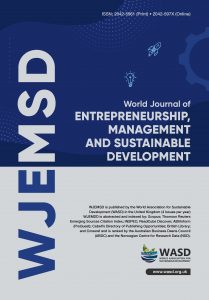(07) Training humanitarian workers through e-learning during a pandemic: a journey towards a sustainable world, Muhammad Shahzad, Dr. Raniyah Wazirali, Prof. Imran Dar, Dr. Lama Khoshaim
 Mr Muhammad Babar Shahzad
Mr Muhammad Babar Shahzad
Country Manager, Pakistan Currency Exchange
Pakistan
Email: babar.iiui@live.com/babar@paksitancurrency.com
Dr. Raniyah Wazirali
College of Computing and Informatics
Saudi Electronic University
Riyadh 11673
Saudi Arabia
Email: r.wazirali@seu.edu.sa
Prof. Dr Imran Bashir Dar
Assistant Professor at Foundation University Islamabad (FUI)
Faculty of Management Sciences, Department of Business Administration
Rawalpindi Campus
Pakistan
Email: imran.bashir@fui.edu.pk
Dr. Lama Sameer Khoshaim
College of Administrative and Financial Sciences
Saudi Electronic University
Riyadh 11673
Saudi Arabia
Email: l.khoshaim@seu.edu.sa
DOI: 10.47556/J.WJEMSD.19.3-4.2023.7
PURPOSE: Natural disasters due to climate change affect more than two hundred million people every year. Compared to any point in recorded history, a high proportion of the global population has been affected by floods and pandemic in recent years. Notably, the capacity of humanitarian workers through online, blended, and conventional forms of learning is one of the priorities of embedding the Sustainable Development Agenda 2030 (WHO, 2018).
OBJECTIVES:
1. Whether digital mode and face-to-face mode are equally effective in training humanitarian workers?
2. Do humanitarian workers trained through digital mode and face-to-face mood perform equally well academically?
3. Do humanitarian workers trained through digital mode and face-to-face mood perform equally well in a crisis?
4. Do humanitarian workers trained through digital mode and face-to-face mode perform equally well in post-crises aid work?
DESIGN/METHODOLOGY/APPROACH: An online course was developed with the help of a registered nursing college. The course content was based on already established international practices for emergency response in disasters and developed with the help of national nursing council guidelines. The humanitarian workers were selected from one organisation based on convenience sampling and divided into two groups. The first group comprised 48 workers working as primary healthcare providers in these two remote areas of the country. The second group consisted of 34 humanitarian workers working in the same area as primary health workers. The first group was given training through online media, and the second group was given training via the conventional method.
FINDINGS: The mode of education was decoded into dummy variables, 1 for conversation learning and 2 for e-learning. The academic performance of humanitarian workers was obtained from the course teacher, and humanitarian workers’ job performance was obtained from the district manager. The internal consistency of the scale was obtained using the alpha reliabilities of the scales. Descriptive statistics tests were also conducted to measure the mean, standard deviation, and correlation between variables. The humanitarian workers trained through e-learning performed well academically compared to the second group. The reasoning is that the workers having e-learning medium had the leverage to study at their own pace and repeat it at their convenience. Both groups were sent to the field during recent floods, and their progress was monitored and compared. The results revealed that both groups performed equally well. However, one group performed well in the psychological care of the vulnerable population.
ORIGINALITY/VALUE OF THE PAPER: These results concluded that we could use an online education mode to train humanitarian workers in remote areas. The E-learning exercise enhanced their psychological resilience as they were directed to use their cognitive abilities instead of team dynamics and social setting behavioural consciousness. However, the humanitarian workers trained through conventional education performed well compared to the first group in post-crisis field activities as they exercised their social setting behaviour. Our study demonstrated that training humanitarian workers through e-learning is as effective as conventional methods. However, there are pros and cons to both training methods. More research and longitudinal research are recommended to generalise the results across all settings.
KEYWORDS: Humanitarian Workers; E-Learning; Sustainable Development Goals; Life-Saving Relief Assistance; Performance.

